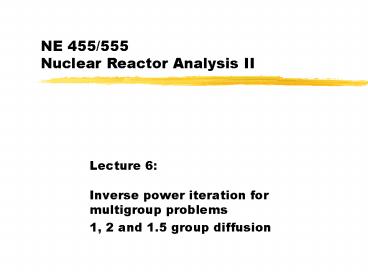NE 455555 Nuclear Reactor Analysis II - PowerPoint PPT Presentation
1 / 9
Title:
NE 455555 Nuclear Reactor Analysis II
Description:
... dividing energy E1 between the two energy groups so that ... One-and-a-half group diffusion? If we make the following approximation in our two group equations ... – PowerPoint PPT presentation
Number of Views:61
Avg rating:3.0/5.0
Title: NE 455555 Nuclear Reactor Analysis II
1
NE 455/555Nuclear Reactor Analysis II
- Lecture 6Inverse power iteration for
multigroup problems - 1, 2 and 1.5 group diffusion
2
So, we know how to solve multigroup fixed source
problems. What about k?
- If we include the k-eigenvalue in our multigroup
diffusion equations we getwhere
3
We apply inverse power iteration in a way
analogous to the 1-group problem
- Begin with
- Then solve
- Compute the new k, as before
4
Inverse Power Iteration, cont
- Now, we normalize the fission source
- We need to iterate this process until
5
Lets look at specific examples of multigroup
systems
- First, what if you have only one group? Answer
you get the one- group equations - What about two-groups?
6
Two group diffusion
- We choose the dividing energy E1 between the two
energy groups so that - (no neutrons scatter up from the
thermal group to the fast group) - (all fission neutrons are fast)
- Then the general two group problem is
7
Two group diffusion, cont
- With our choice of dividing energy we
obtainwhere - We will look in more detail at these two group
equations in our next lecture.
8
One-and-a-half group diffusion?
- If we make the following approximation in our two
group equationsthen we findand - This equation can be solved as quickly as a
standard one-group equation, but has some
two-group physics built in.
Thermal neutrons are much more likely to be
absorbed than to leak out of the system.
9
One-and-a-half group diffusion, cont
- This model is at the heart of the codes used to
design most of the reactors currently in
operation in the U.S. - GEs FLARE code
- Siemens XTG code
- Over the last 5-8 years, most of the industry
standard core simulator codes have gone to
two-groups. - Multigroup is still too expensive for the
improvement in accuracy obtained.































